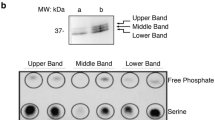Abstract
Human leukocyte function-associated antigens (LFA) have been defined by their association with human T lymphocyte-mediated cytolysis (1). One of these, LFA-1, is present on lymphocyte, thymocytes, monocytes, and granulocytes. Antibodies to LFA-1 have been shown to interfere with T lymphocyte-mediated cytotoxicity, NK cell-mediated cytolysis, and T cell proliferation to soluble antigens, alloantigens, and mitogens as well as various myeloid cell functions (1–4). OKM1 is a biomolecular structure and it has been identified to be the C3bi receptor of human monocytes and macrophages (5). Recently, LFA-1 and OKM1 were found to have a common ß subunit and they belong to a human leukocyte differentiation antigen family (6).
Access this chapter
Tax calculation will be finalised at checkout
Purchases are for personal use only
Preview
Unable to display preview. Download preview PDF.
Similar content being viewed by others
References
Sanchez-Madrid, F., A.M. Krensky, C.F. Ware, E. Robbins, J.L. Strominger, S.J. Burakoff, and T.A. Springer. 1982. Three distinct antigens associated with human T-lymphocyte-mediated cytolysis: LFA-1, LFA-2, and LFA-3. Proc. Natl. Acad. Sci. U.S.A. 79: 7489.
Hildreth, J.E.K., F.M. Gotch, P.D.K. Hildreth, and A J. McMichael. 1983. A human lymphocyte-associated antigen involved in cell-mediated lympholysis. Eur. J. Immunol. 13: 202.
Krensky, A.M., F. Sanchez-Madrid, E. Robbins, J.A. Nagy, T.A. Springer, and S.J. Burakoff. 1983. The functional significance, distribution, and structure of LFA-1, LFA-2, and LFA-3: cell surface antigens associated with CTL-target interactions. J. Immunol. 131: 611.
Beatty, P.G., J.A. Ledbetter, P.J. Martin, T.H. Price, and J.A. Hansen. 1983. Definition of a common leukocyte cell surface antigen (Lp 95–150) associated with diverse cell mediated immune functions. J. Immunol. 131: 2913.
Wright, S.D., P.E. Rao, W.C. Van Voorhis, L.S. Craigmyle, K. Iida, M.A. Talle, E.F. Westberg, G. Goldstein, and S.C. Silverstein. 1983. Identification of the C3bi receptor of human monocytes and macrophages by using monoclonal antibodies. Proc. Natl. Acad. Sci. U.S.A. 80: 5699.
Sanchez-Madrid, F., J.A. Nagy, E. Robbins, P. Simon, and T.A. Springer. 1983. A human leukocyte differentiation antigen family with distinct a-subunits and a common ß-subunit: the lymphocyte function associated antigen (LFA-1), the C3bi complement receptor (OKM1/Mac-1), and the pl50,95 molecule. J. Exp. Med. 158: 1785.
Cohen, P. 1982. The role of protein phosphorylation in neural and hormonal control of cellular activity. Nature 296: 613.
Yes, S.H., F. Gaskin, and S.M. Fu. 1983. Neurofibrillary tangles in senile dementia of the Alzheimer type share an antigenic determinant with intermediate filaments of the vimentin class. Am. J. Pathol. 113: 373.
Wright, S.D., and S.C. Silverstein. 1982. Tumor-promoting phorbol esters stimulate C3b and C3b’ receptor-mediated phagocytosis in cultured human monocytes. J. Exp. Med. 156: 1149.
Chaplin, D.D., H.J. Wedner, and C.W. Parker. 1980. Protein phosphorylation in human peripheral blood lymphocytes: mitogen-induced increases in protein phosphorylation in intact lymphocytes. J. Immunol 124: 2390.
Johnstone, A.P., J.H. DuBois, and M.J. Crumpton. 1981. Phosphorylated lymphocyte plasma-membrane proteins. Biochem. J. 194: 309.
Wang, C.Y., A. Al-Katib, C.L. Lane, B. Koziner, and S.M. Fu. 1983. Induction of HLA-DC/DS (Leu 10) antigen expression by human precursor B cell lines. J. Exp. Med. 158: 1757.
Cooper, J.A., B.M. Sefton, and T. Hunter. 1983. Detection and quantification of phosphotyrosine in proteins. Methods Enzymol. 99: 387.
Castagna, M., Y. Takai, K. Kaibuchi, K. Sano, U. Kikkawa, and Y. Nishizuka. 1982. Direct activation of calcium-activated, phospholipid-dependent protein kinase by tumor-promoting phorbol esters. J. Biol. Chem. 257: 7847.
Jacobs, S., N.E. Sahyoun, A.R. Saltiel, and P. Cuatrecasas. 1983. Phorbol esters stimulate the phosphorylation of receptors for insulin and somatomedin C. Proc. Nad. Acad. Sci. U.S.A. 80: 6211.
May, W.S., S. Jacobs, and P. Cuatrecasas. 1983. Association of phorbol ester-induced hyperphosphorylation and reversible regulation of transferrin membrane receptors in HL60 cells. Proc. Natl. Acad. Sci. U.S.A. 81: 2016.
Sibley, D.R., P. Nambi, J.R. Peters, and R.J. Lefkowitz. 1984. Phorbol diesters promote ß-adrenergic receptor phosphorylation and adenylate cyclase desensitization in duck erythrocytes. Biochem. Biophys. Res. Commun. 121: 973.
Nishizuka, Y. 1984. The role of protein kinase C in cell surface signal transduction and tumour promotion. Nature 308: 693.
Iwashita, S., and C.F. Fox. 1984. Epidermal growth factor and potent phorbol tumor promoters induce epidermal growth factor receptor phosphorylation in a similar but distinctively different manner in human epidermoid carcinoma A431 cells. J. Biol. Chem. 259: 2559.
Moon, S.O., H.C. Palfrey, and A.C. King. 1984. Phorbol esters potentiate tyrosine phosphorylation of epidermal growth factor receptors in A431 membranes by a calcium-independent mechanism. Proc. Natl. Acad. Sci. U.S.A. 81: 2298.
Goldfarb, R.H. and R.B. Herberman. 1981. Natural killer cell reactivity: regulatory interactions among phorbol ester, interferon, cholera toxin and retinoic acid. J. Immunol. 126: 2129.
Andreotti, P.E. 1982. Phorbol ester tumor promoter modulation of alloantigen-specific T lymphocyte responses. J. Immunol. 129: 92.
Oroscz, C.G., D.C. Roopenian, and F.H. Bach. 1983. Phorbol ester mediates reversible reduction of cloned T lymphocyte cytolosis. J. Immunol. 130:2499.
Editor information
Editors and Affiliations
Rights and permissions
Copyright information
© 1986 Springer-Verlag New York Inc.
About this paper
Cite this paper
Hara, T., Fu, S.M. (1986). Phosphorylation of α,ß Subunits of 180/100-Kd Polypeptides (LFA-1) and Related Antigens. In: Reinherz, E.L., Nadler, L.M., Haynes, B.F., Bernstein, I.D. (eds) Leukocyte Typing II. Springer, New York, NY. https://doi.org/10.1007/978-1-4612-4850-7_6
Download citation
DOI: https://doi.org/10.1007/978-1-4612-4850-7_6
Publisher Name: Springer, New York, NY
Print ISBN: 978-1-4612-9329-3
Online ISBN: 978-1-4612-4850-7
eBook Packages: Springer Book Archive




